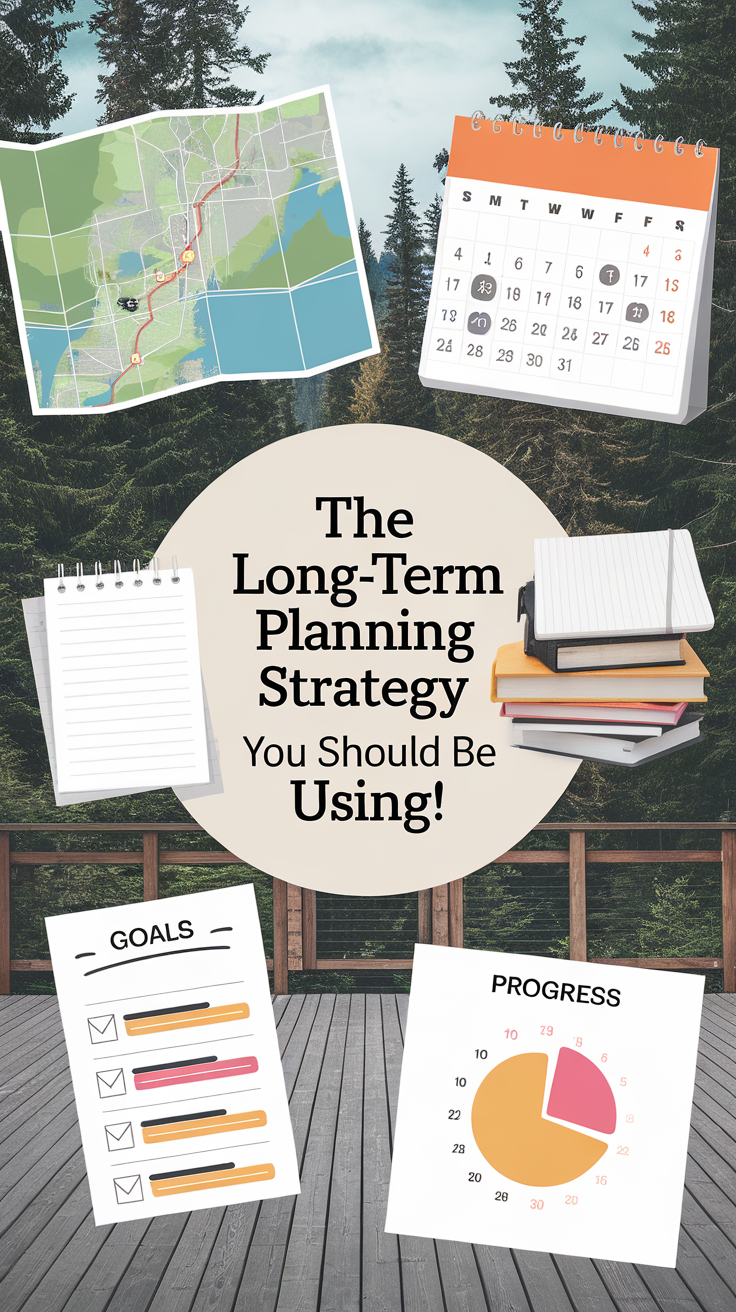The Long-Term Planning Strategy You Should Be Using!
To develop a successful long-term planning strategy, start by defining a clear vision that aligns with your core values. Set specific, achievable goals that serve as a roadmap. Embrace adaptability to navigate unforeseen challenges; this flexibility is essential for resilience. Regularly evaluate your progress using defined metrics and adjust your strategies accordingly. Identify potential obstacles and utilize tools like the Eisenhower Matrix for prioritization. Finally, stay motivated by breaking down long-term goals into manageable tasks and celebrating milestones. By focusing on these elements, you’ll enhance your planning effectiveness and better prepare for the future ahead. There’s more to explore in achieving this success!
Key Takeaways
- Develop a clear vision statement that aligns with your core values to guide your long-term planning efforts.
- Break down long-term goals into specific, measurable, and time-bound action items to maintain focus and direction.
- Establish key performance metrics and schedule regular check-ins to monitor progress and ensure accountability.
- Cultivate adaptability by preparing for unforeseen challenges and maintaining flexibility in decision-making.
- Set incremental goals and celebrate milestones to sustain motivation and reinforce commitment to your vision.
Importance of Long-Term Planning
Recognizing the significance of long-term planning can be a game-changer for both individuals and organizations. By engaging in this process, you cultivate strategic foresight, enabling you to anticipate future challenges and opportunities. This foresight is essential; without it, you risk reacting to situations rather than proactively shaping your path.
The long-term benefits of effective planning are manifold. First, it fosters resilience—when you’ve considered various scenarios, you’re better equipped to navigate uncertainties.
Second, long-term planning boosts resource allocation efficiency; you can prioritize investments and efforts that align with your overarching goals.
Moreover, this approach encourages a culture of accountability. When everyone understands the long-term objectives, it nurtures a shared commitment to collaborative success.
As you implement your plans, you’ll find that measuring progress becomes more straightforward, allowing for timely adjustments.
Ultimately, investing time in long-term planning isn’t merely an exercise in goal-setting; it’s a strategic imperative. By prioritizing this practice, you position yourself or your organization to harness opportunities, mitigate risks, and achieve sustainable growth.
Embrace long-term planning today, and watch as it transforms your ability to thrive in an ever-evolving landscape.
Defining Your Vision
Often, the clarity of your vision can determine the success of your long-term planning efforts. When you define your vision with precision, you create a solid foundation for effective planning.
Vision clarity guarantees that every step you take aligns with your ultimate objectives, fostering vision alignment across all areas of your life.
Here are three key steps to help you refine your vision:
-
Identify Core Values****: Reflect on what truly matters to you. Your core values will guide your vision and keep you grounded during challenging times.
-
Envision the Future: Picture where you want to be in 5, 10, or even 20 years. Consider the impact you wish to have and the legacy you hope to leave behind.
-
Articulate Your Vision: Write down a succinct statement encapsulating your vision. This statement should be clear, inspiring, and easily referable, serving as a touchstone for your planning efforts.
Setting Achievable Goals
To successfully set achievable goals, you need to define clear objectives that align with your vision.
Breaking down these objectives into manageable milestones allows you to track your progress effectively.
Regularly monitoring your advancement guarantees you stay on course and can adjust your strategy as needed.
Define Clear Objectives
Setting achievable goals is vital for effective long-term planning, and having clear objectives can make all the difference. When you define clear objectives, you create a roadmap that aligns with your overall vision.
This objective alignment is fundamental to guarantee that every action you take leads toward measurable outcomes.
To set clear objectives, consider these three key strategies:
-
Be Specific****: Clearly articulate what you want to achieve. Vague goals lead to confusion and lack of direction.
-
Make It Measurable: Establish quantifiable metrics to assess your progress. This will help you track your success and adjust your strategies as necessary.
-
Set a Timeline: Define deadlines for your objectives. A time-bound approach creates urgency and encourages consistent action.
Break Down Milestones
Breaking down milestones is essential to transforming your long-term objectives into manageable, achievable goals. By segmenting your overarching aims, you create a clear roadmap that guides your actions and keeps you focused.
Start by identifying key milestones that align with your ultimate goal. Each milestone should represent a significant step forward, allowing for effective milestone tracking.
Once you’ve defined these milestones, establish specific criteria for achieving each one. This not only clarifies your path but also facilitates measurable progress.
As you reach each milestone, take the time to celebrate these achievements. Milestone celebration isn’t just about acknowledging success; it reinforces motivation and builds momentum for the next phase of your journey.
Incorporating both tracking and celebration into your strategy fosters a sense of accomplishment and accountability. You’ll find that these practices not only enhance your productivity but also deepen your commitment to your long-term vision.
Monitor Progress Regularly
Monitoring progress regularly is essential for guaranteeing that your long-term goals remain within reach. Effective progress tracking allows you to assess your performance and make necessary adjustments.
To maximize your efforts, consider the following three strategies:
-
Establish Key Performance Metrics****: Identify specific metrics that reflect your progress. These could include deadlines met, tasks completed, or milestones achieved. By quantifying your efforts, you can objectively evaluate where you stand.
-
Schedule Regular Check-Ins: Set aside dedicated time—weekly or monthly—to review your progress. During these sessions, analyze your performance metrics and determine if you’re on track. This not only promotes accountability but also helps you stay focused on your goals.
-
Adjust Goals as Necessary: Flexibility is vital. If you find that certain goals are consistently out of reach, it may be time to recalibrate. Adjusting your goals guarantees they remain achievable and relevant, allowing you to maintain motivation and momentum.
The Role of Adaptability
In today’s rapidly changing environment, your ability to embrace change effectively is essential for long-term success.
Flexibility in decision-making not only allows you to respond to unforeseen challenges but also positions you to future-proof your strategies.
Embracing Change Effectively
A significant aspect of effective long-term planning lies in how well individuals and organizations can embrace change. Change management isn’t just about responding to new developments; it’s about actively engaging with uncertainty to leverage opportunities.
By fostering a mindset that welcomes adaptation, you position yourself for sustained success.
Here are three key strategies for embracing change effectively:
-
Cultivate a Growth Mindset****: Encourage a culture where challenges are viewed as opportunities for learning. This mindset helps you navigate uncertainty more confidently.
-
Implement Proactive Communication*: Guarantee *transparent communication channels within your organization. Sharing information about anticipated changes and their implications fosters trust and prepares everyone for modifications.
-
Develop Resilient Teams****: Invest in training that equips your teams with skills to adapt to new circumstances. Resilient individuals are better prepared to face unexpected challenges and can pivot strategies when necessary.
Flexibility in Decision-Making
Embracing flexibility in decision-making is essential for steering through today’s dynamic environment. In a world characterized by rapid change, adopting flexible frameworks allows you to respond effectively to unforeseen circumstances. By integrating adaptability into your strategy, you enable your organization to make timely strategic pivots that can capitalize on emerging opportunities.
| Key Aspect | Importance | Action Steps |
|---|---|---|
| Embracing Change | Facilitates proactive responses | Regularly assess market trends |
| Collaborative Culture | Enhances idea generation | Foster open communication |
| Continuous Learning | Builds resilience | Invest in training programs |
| Scenario Planning | Prepares for uncertainties | Develop multiple action plans |
| Feedback Mechanisms | Informs decision-making | Implement regular reviews |
Future-Proofing Strategies
To thrive in an unpredictable future, organizations must prioritize adaptability as a cornerstone of their long-term planning strategies. Embracing adaptability not only helps you navigate change but also aligns with sustainable practices and harnesses technological advancements to foster resilience.
Here are three key strategies to enhance adaptability:
-
Continuous Learning: Cultivate a culture of ongoing education and skills development. Encourage your team to stay abreast of industry trends and emerging technologies. This proactive approach guarantees that your organization can pivot quickly in response to new challenges.
-
Agile Processes: Implement agile methodologies that allow for iterative decision-making and rapid responses to market shifts. By breaking projects into smaller segments, you can assess outcomes frequently and adjust your strategies as necessary.
-
Collaboration and Networking: Build strong networks within and outside your organization. Leverage partnerships to share insights, resources, and best practices, fostering an ecosystem of support that enhances your adaptability.
Creating an Action Plan
Creating an effective action plan is essential for translating long-term goals into manageable steps that foster progress and accountability. To do this, you’ll want to break down your overarching objectives into specific action items. These items should be clear, measurable, and time-bound—creating a roadmap that guides your daily activities.
Next, consider the role of accountability partners. Collaborating with others who share your vision can amplify your commitment. These partners can provide motivation, offer constructive feedback, and help you remain focused on your goals. Schedule regular check-ins to discuss progress, challenges, and adjustments to your action plan.
Once you’ve established your action items and enlisted accountability partners, prioritize your tasks. Use techniques like the Eisenhower Matrix to differentiate between what’s urgent and important. This prioritization helps you allocate time and resources effectively, ensuring you’re working on what truly matters.
Finally, document your action plan. A written record not only enhances clarity but also serves as a powerful tool for reflection as you progress. By committing to this structured approach, you’ll enhance your ability to achieve long-term success and make meaningful strides toward your aspirations.
Regularly Evaluating Progress
In the domain of long-term planning, regularly evaluating progress is essential for staying aligned with your goals. By consistently appraising your trajectory, you can guarantee your strategies remain effective and adaptive.
Implementing strong progress metrics will help you gauge where you stand and how to pivot if necessary.
To make your evaluation process more structured, consider these three key steps:
-
Set Clear Metrics****: Define specific, measurable indicators of success. This could include milestones, timelines, or quantitative goals that underline your overall objectives.
-
Establish Feedback Loops****: Create mechanisms for ongoing feedback, whether from peers, mentors, or self-assessments. This iterative process enables you to recalibrate your approach based on real-time insights.
-
Review and Revise: Schedule regular check-ins to analyze your progress. Use these sessions to reflect on what’s working and what needs adjustment, guaranteeing that your planning strategy remains dynamic.
Overcoming Common Challenges
[TEXT]:
What obstacles might you encounter on the path to achieving your long-term goals? Understanding these common obstacles is vital for your success. Often, you’ll face issues like time constraints, insufficient resources, or unexpected setbacks. These challenges can derail your progress if not addressed promptly.
To navigate these hurdles effectively, consider implementing strategic solutions. First, prioritize time management. Break your goals into manageable tasks and allocate specific time slots for each. This structured approach helps you focus on what truly matters.
Second, assess your resource availability. Whether it’s financial backing or support from peers, make sure you have what you need to move forward.
Additionally, prepare for the unexpected. Develop contingency plans that outline alternative paths when faced with setbacks. This proactive mindset guarantees you’re not caught off guard when challenges arise.
Finally, cultivate a growth mindset. Embracing a perspective that views obstacles as opportunities for learning can transform your approach to problem-solving.
Sustaining Motivation and Focus
Sustaining motivation and focus over the long term can be challenging, especially when the initial excitement of pursuing a goal fades.
To maintain your drive and clarity, you need effective motivation techniques and focus strategies. Here are three key approaches to contemplate:
-
Set Incremental Goals****: Break your larger objectives into smaller, manageable tasks. This not only makes your goals less intimidating but also provides a sense of achievement as you complete each step, fueling your motivation.
-
Create a Routine: Establish a daily schedule that incorporates dedicated time for working on your goals. Consistency fosters discipline and helps reinforce focus, making it easier to stay on track amidst distractions.
-
Reflect and Adjust: Regularly assess your progress and strategies. Reflection allows you to identify what’s working and what isn’t.
Be willing to adapt your approach based on your findings to guarantee sustained motivation and sharpened focus.
Frequently Asked Questions
How Can I Involve My Team in Long-Term Planning?
To weave your team’s vision into long-term planning, spark creativity through team brainstorming sessions and ignite collaboration in workshops. These platforms cultivate shared insights, empowering everyone to shape a future that resonates with collective ambition.
What Tools Can Help With Tracking Long-Term Goals?
To effectively track long-term goals, consider utilizing goal tracking software and progress monitoring tools. They provide insights into milestones, enable accountability, and facilitate adjustments, ensuring you stay aligned with your strategic objectives over time.
How Do I Stay Committed to My Long-Term Plan?
Did you know that 80% of people abandon their long-term goals? To stay committed, employ commitment techniques like accountability partners and motivation strategies such as visual reminders to reinforce your resolve and keep progress on track.
What Are Common Mistakes in Long-Term Planning?
When planning long-term, you might overestimate timelines, leading to frustration. Additionally, neglecting flexibility can hinder your ability to adapt. Recognizing these common mistakes is essential for refining your approach and achieving your goals effectively.
How Often Should I Review My Long-Term Strategy?
You wouldn’t want your strategy gathering dust like an old trophy, right? Aim for quarterly review intervals to guarantee your strategy frequency keeps you aligned with changing goals. Regular assessments lead to mastery and success!



